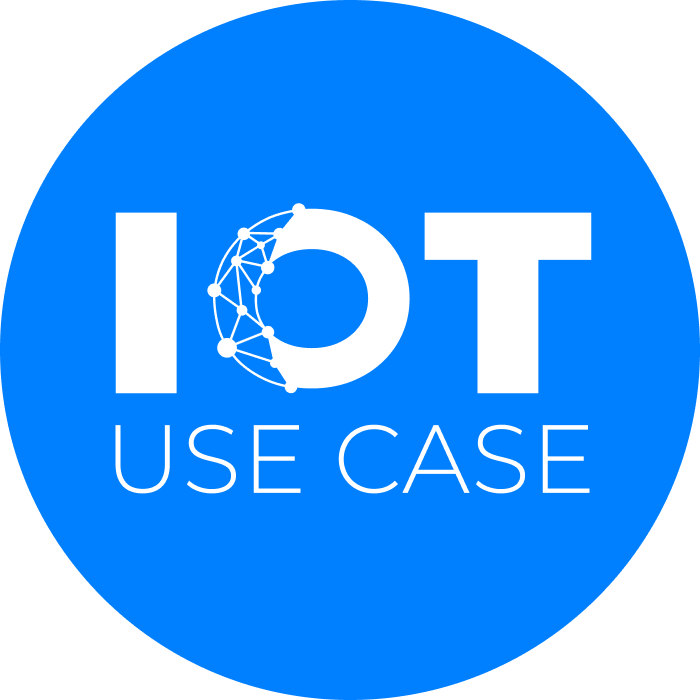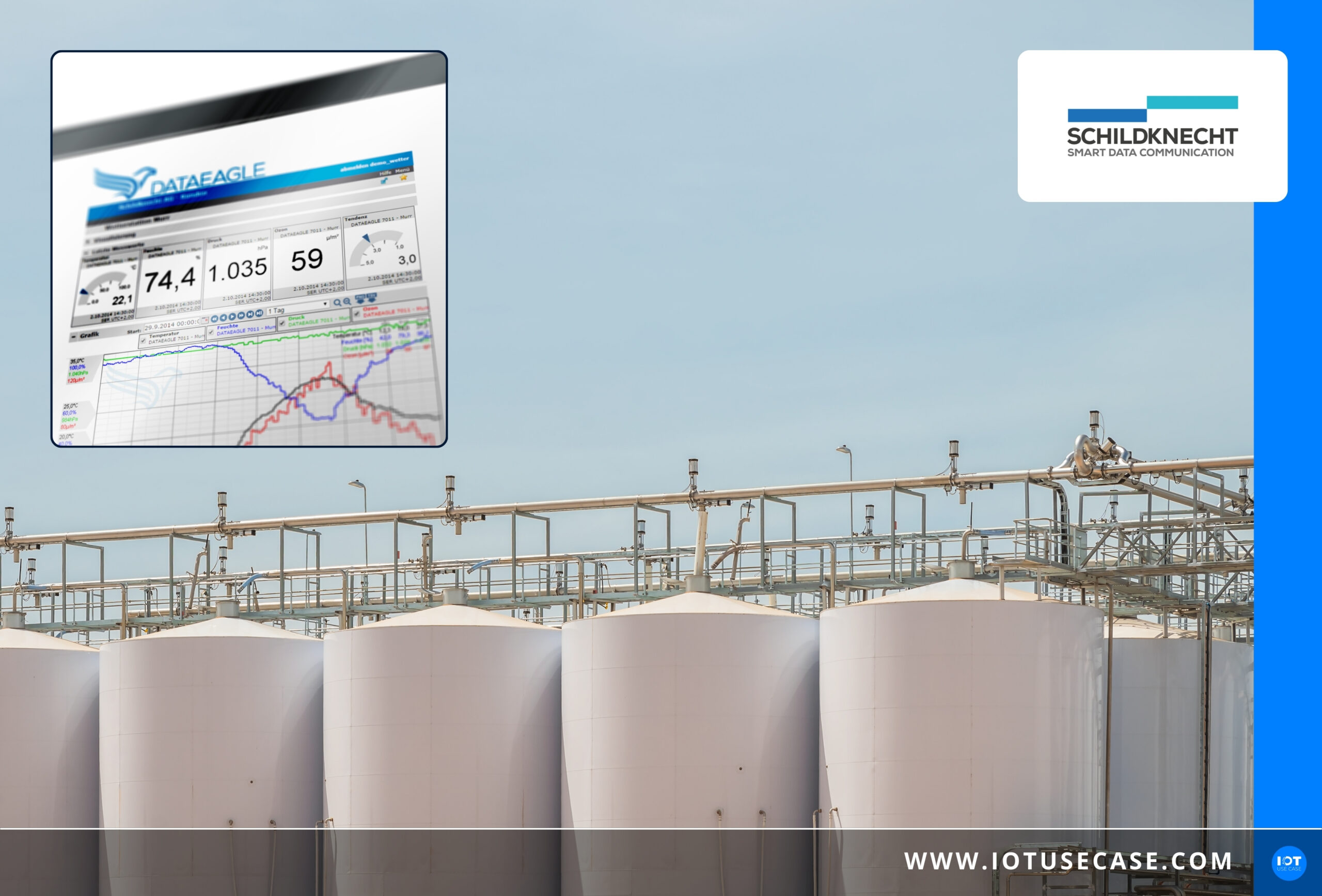In this podcast episode, we discuss the application of cloud-based supply chain monitoring to detect anomalies such as fuel theft early on and take appropriate countermeasures. We discuss the challenges of global supply chains and supply chain management, particularly in areas with limited digitalization.
Episode 98 at a glance (and click):
- [08:34] Challenges, potentials and status quo – This is what the use case looks like in practice
- [17:58] Solutions, offerings and services – A look at the technologies used
- [28:52] Results, Business Models and Best Practices – How Success is Measured
Podcast episode summary
In Episode 98, we delve into a specific case study where a major beverage manufacturer in Nigeria installed a sensor-based tank level monitor to capture real-time data such as fill level and flow rate. This solution, provided by Schildknecht AG, utilized cellular-based IoT technology to monitor the supply chain. Schildknecht AG is a family-owned company that has been developing data transmission solutions for over 40 years. Many of their customers are system integrators.
We delve into the technical details and explain how the DATAEAGLE 7000 series cellular gateway and the DATAEAGLE Portal device cloud work together to ensure secure data transmission. Furthermore, we discuss how the data can be analyzed to calculate daily consumption or issue alerts for specific fill levels.
Finally, we discuss how this IoT solution saves costs and reduces personnel effort, eliminates sources of error, and helps identify anomalies automatically. Together with Elena Eberhardt (Member of Advisory Board, Business Development & Marketing Manager, Schildknecht AG) and Didier Kärst (Product Manager Wireless & IoT, Schildknecht AG), we embark on an exciting journey into the world of digitalized supply chain monitoring.
"Thomas Schildknecht (CEO, Schildknecht AG) on the uniqueness of the featured project (not included in the podcast)."
Can you summarize again what makes the project, let’s say, special? You just mentioned the “Bastler Bude” where you had an exchange with a competitor, highlighting what makes you special there. Can you maybe emphasize briefly what makes the project special in Nigeria?
What makes this project special is that it is through the complete functionality that we enable, including the SIM card, that we are able to implement any project worldwide remotely, from Germany, without even knowing the customer on-site, without having to fly down there to negotiate and implement the project. And that’s what they experience every day. They have to transmit the low costs for the cellular network to us in real-time, but nonetheless, the costs are transferred in real-time, and normally they would require a trusting relationship. The alternative, and this became apparent to me during a discussion with a competitor at the Hanover Fair, is that they generally say: “We leave the entire SIM card issue to our end customers.”
Our beverage manufacturer, who ultimately uses the data, wouldn’t do that. The automation company, a small company with ten people, who specialize more in control technology, couldn’t do it either. Der könnte das nicht tun. We can’t buy and use a Nigerian SIM card in Germany. So, we really needed the functionality down to the smallest detail. And in this case, the smallest detail is also performing real-time data billing. What if the customer doesn’t pay? We cannot be left with the costs because it is a European cellular contract running in the background through what Didier mentioned, this “unsteered roaming.” So, costs do accumulate, and over the past years, there was even a month where the automatic monitoring kicked in because the costs hadn’t been paid into that prepaid account. And then for just one day, the data logger was not read, and once the money was received again, the process automatically resumed.
So, one has to consider such small things when covering a project of this scale, and speaking of scale, I explicitly say: there are only ten stations. So, we don’t have a large project where we have a project manager managing thousands of stations, but we can do something like this with just a single unit. We also say IoT starts with a single device. It can be a proof of concept for us, but it can also be the final expansion with ten stations in this application, and we manage it without having to have personnel here on-site.
Podcast interview
It is 9:30 a.m. German time and a call is received from Nigeria to the service department of an automation company – 100 liters of fuel were stolen from us this morning! We are standing at the tank, and it appears that someone has siphoned off the fuel. Can you inform us at the headquarters which customer order this was and what consumption occurred here at what time? Thank you very much.
This is called supply chain monitoring, among other things, and it is just one use case of hundreds currently being implemented by companies. In this case, the customer involved was actually one of the largest beverage manufacturers in the world, and many of them do not have the ability to track the specific consumption for each delivery. Because neither the tank level information is available, nor the flow or data from generators.
Currently, many system integrators such as automation companies or manufacturers of components, be it fans or pumps, but also equipment manufacturers or machine and plant manufacturers are in the process of collecting data for their customers from anywhere in the world and delivering added value for cost savings for precisely such use cases.
Today, we’ll learn from Schildknecht about how customers are going about it and, more importantly, how automation companies are building a billing model, based on three use cases and related real-world projects. It is important to have a solution in place where you can monitor cellular communication costs, especially billing, as sometimes payments for cellular expenses are not made.
You need to consider such and many other small things, and now you will find out what those are. Let me introduce you to our speakers. First, we have Didier, who is the Product Manager for Wireless and IoT at Schildknecht AG. And joining him is Elena Eberhardt, the Business Development Manager at Schildknecht AG.
Hi Didier and Elena, great to have you with us today and welcome to the IoT Use Case Podcast! Didier, how are you? Where are you at the moment?
Didier
Thank you also for the invitation, I’m fine and I’m in Murr today at our company. Murr is located in the district of Ludwigsburg, slightly north of Stuttgart and south of Heilbronn and Ludwigsburg.
I just typed that into Google Maps, it’s pretty easy to find. You’re outside Ludwigsburg, a bit in the countryside, aren’t you?
Didier
That’s right, it’s a small community here.
Greetings in your direction. Elena, where are you? Are you in the same location? And how are you doing?
Elena
Hi Madeleine, I’m working from home today. A wonderful good morning to you from Mannheim.
I’m very happy that you are with us today! You are Schildknecht AG and your history is primarily in IoT machine communications via cellular and wireless technologies and have been developing corresponding data transmission solutions for over 40 years. You offer IoT edge gateways with interfaces where the data can be pre-processed and transferred to the cloud. Here you also have your own portal, I think the brand is called DATAEAGLE, like the eagle.
What makes you special is that many of your customers are system integrators who, so to speak, use your devices and machines with the corresponding area-wide connectivity globally and also use the portal from you.
From my perspective, this is a very large market where many device manufacturers, machinery builders, and component manufacturers are heading in the same direction. It’s really nice to see that these are your customers too. You are a family business, which I personally find very nice.
Didier, first to you, you are Product Manager, Wireless and IoT at Schildknecht AG. Can you tell us about the clients you work with?
Didier
Due to our wireless technologies, we are heavily involved in the automation sector, which is diversified and wide-ranging. Wherever there is something to automate, there are our customers, i.e. end customers who use our technologies, but also system integrators who implement the automation solution at end customers.
Elena, can you share some use cases and the underlying projects of your customers? Which project are we looking at in detail today?
Elena
We have a wide variety of use cases, and I would like to briefly touch on three. One use case we often have is shopfloor automation or even shopfloor monitoring. It now runs under IoT or under Industry 4.0 projects, where we visualize machine data and collect it mostly via sensors on the individual machines, often transmit it wirelessly, and then visualize it at a central location via a central PLC. There, we have the opportunity to work with the data and take action. For example, when there are certain alarms of temperature exceedances.
I was just wondering what you guys were doing on the shopfloor. But of course, you also have the option of transmitting the data from the shopfloor via cellular communications. Cool case!
Elena
It is often desired and a good variant if you already have an existing infrastructure and want to save additional cables. You are much more flexible and faster if you do the whole thing wirelessly. Simply via a Bluetooth solution over a few meters, so up to 30 to 40 meters is not an issue at all.
Another use case we recently implemented is with an energy provider. We connect various pumping stations there, which are spread over a large area of about 4 to 5 kilometers. Again, these are sensor values that we are collecting here.
In this case, we don’t visualize them centrally in one place, but instead do this classic, bidirectional communication that we know from automation technology and import the data directly into the PLC. We still do it via our cloud, the cloud is completely invisible to the customer in this case with our portal.
The third use case is a fantastic project that we implemented in Nigeria some time ago, and it has been thriving ever since, meaning that it has continued to evolve. We provide tank level monitoring solutions and assist a system integrator in implementing it for their end customer. It is about monitoring the diesel tanks for energy supply. The goal is to ensure how much diesel is flowing in, how much is flowing out, and how much is remaining in the tank.
There are several reasons for this. On the one hand, to ensure the energy supply, but on the other hand also to monitor billing. Here we are working for a very large beverage manufacturer on another continent.
Challenges, potentials and status quo – This is what the use case looks like in practice [08:34]
Then let’s dive in there and understand what your customer’s challenges are here.
Before I delve into that, I would like to address you, dear listener. If you find this use case or any other use cases intriguing, Elena, Didier, and the management are available here to answer any questions you may have. I’ll link to the LinkedIn profiles in the show notes, feel free to check them out there.
What is your customer’s core business? What are the customers and what are typical processes?
Elena
In this case we work with a system integrator. We do this quite often, because large customers simply like to work with system integrators when it comes to automation technology and a wide variety of projects. By doing so, it becomes easier to bring various manufacturers together and effectively outsource a complete project.
It’s mostly about digitizing processes. This often sounds more exciting than it is, but it’s actually a simple task. That means, for example, in the project in Nigeria, we replace the manual process of recording values and visualizing them. That means we automate the process using sensors, transmit the values via cellular connectivity, visualize the data, and provide the customer, system integrator, and end-user with the ability to easily work with the data.
In other words, your customer is the system integrator and they in turn have an end customer who comes from the beverage industry. The aim is to monitor diesel or fuels, for example.
What are the challenges of your customers, or the potentials that your customer has seen in this context?
Elena
The point is to detect anomalies. These anomalies can be, on the one hand, that the supplier does not deliver diesel at all. This means that no new diesel flows into this main tank at all, and it still bills, for example. Or the billing is done for an incorrect quantity.
This means that our customer, the system integrator, can use the inflow to monitor very precisely how much is ultimately delivered and how much is also billed. They can then make this available to their customer again as a service.
This main tank is connected to different generators, that is, to different process steps. This means that we also see whether everyone is supplied, whether we have an inflow in all directions and whether all processes are running normally. We can also support here by enabling the end customer to see in real time whether their processes are running optimally, as they need them to.
Many customers may not even have that yet. These are different scenarios that can be covered to prevent diesel from being lost or fuel from being lost in the worst case scenario. Can you put it that way?
Elena
That’s exactly how it is!
Your customer is the system integrator, so to speak, or the automation company behind it. That means when your customer obtains the solution from you, they will somehow bill it back to their end customer. Can you address the challenges for automation companies? What’s the challenge of really running the whole thing for the customer?
Elena
The biggest challenge is cellular connectivity, there are two different issues that are important here. One is billing, or: who is ultimately responsible for connectivity? Who pays for that and who keeps them running? This special feature, which we have mapped in our gateways, enables us to deliver the devices with an integrated SIM card and thus provide connectivity all the way to the end customer.
We can still invoice the automation technology company, and they can negotiate the connectivity or service directly with their end customer.
The second point is management capability. The fact that we have the connectivity ready and can also manage it, or that our customer can manage it, means that we can also make technical updates. As we continue to develop the project or processes, we are able to push updates through this centrally managed connectivity as well. Because we never have this issue of the customer calling and saying, “I’ve had my SIM card stolen and connectivity isn’t working”. As a manufacturer, we can still manage that and ultimately provide it.
This is something that many on the market today do not even offer to the same extent. You hear a lot that you have to take care of things yourself. You buy and obtain the SIM card, have the device, and then have to worry about everything else, you also do that.
What is the data that your customer is interested in?
Didier
In this case it is about the monitoring of the tank. That is, these were sensors that were installed there, which on the one hand monitored the fill level of the tank. How much diesel is in the tank, what level is there, how many liters are in there? And the flow rate was also monitored. When diesel was refilled from the outside through the tanker truck, it was controlled how much diesel went into the tank. Then generators are connected, which consume the diesel. There are flow sensors in there, too, that measure how many liters of diesel each generator uses.
For example, to draw conclusions about theft or various other things that I wouldn’t be able to see otherwise, right?
Didier
Exactly! You can see how much diesel went into the tank and what the supplier of the diesel actually charged and if it matches up?
Are there any special technological requirements from your customer for such a solution?
Didier
As the saying goes: appetite comes with eating! Initially, they only wanted to start with the raw sensor values, but then they realized that they could gain more insights by integrating additional data sources. realized that there was still a manual process, namely calculating from the pure flow values: How much is the consumption or what is the current status? At what time is how much consumed? So the customer approached us and asked if we could also calculate that. Because we are talking about an edge gateway in that case, we were able to integrate pre-processing functions there that could pre-process or calculate exactly these values in the gateway.
So, this manual effort has also been eliminated for him. The devices had already been delivered to Nigeria for a long time, and this is a feature that we can offer to them over the air. We were able to deploy these functions into their device on-site in Nigeria and provide new features.
In other words, in addition to the classic cellular communications requirements, it was also a question of saying: I’m starting with a simple sensor value and also the requirement to be able to expand the whole thing, and that’s where I fall back on a partner who can support the whole thing holistically.
Solutions, offerings and services – A look at the technologies used [17:58]
Can you show me the solution you created together? What exactly can the solution do?
Didier
Basically, our DATAEAGLE IoT solution is the interface between the automation world or sensor world on the one hand, and the cloud on the other.
We solve the entire gap that arises in between. So how do you collect the data, how do you pre-process it, and how do you transmit it over cellular? Anywhere in the world to a central point where they end up in the cloud again and from there they can either be processed further in our cloud or passed on to external systems.
In that case, it was in Nigeria distributed in different locations where those sensor readings were taken and transmitted to the central location to us in the cloud to provide that to the end customers.
How exactly does data acquisition work here? That’s coming from a sensor somewhere, how does that end up with you guys?
Didier
In the case, the automation company preprocessed these sensor values locally. We didn’t supply a sensor interface there, they were pre-processed locally because that was the existing installation. This local pre-processing had a Modbus RTU interface and there we offer gateways that also commuinicate with the Modbus RTU. From this local pre-processing, we were able to read the sensor values and then import them into our Edge Gateway. The edge gateway, in turn, has cloud connectivity via cellular and then transferred the data to the cloud.
Modbus RTU has become the standard on the market. I’m familiar with many projects that come in, and they are all solved using Modbus RTU.
Didier
It’s definitely an important interface, yes.
You just said that the data is processed via cellular communications. You probably have a SIM card somewhere that is inserted on this device, or rather on the circuit board. Can you explain how the data flows to the next level via cellular connectivity?
Didier
That’s where we have a very special solution. Once, the SIM card is integrated on the device or is supplied with the device, so the customer does not have to worry about which SIM card to use there. It offers worldwide roaming, called “unsteered roaming”. This means that we can operate here with any mobile operator worldwide. This is very important for the customer because it gives them a plug-and-play solution from us to collect the data on site, via any cellular provider that is available at the site, and transfer it to our portal.
With consistent pricing worldwide. It doesn’t matter whether the system is used in Germany, Nigeria or the USA, the data transfer costs will always be the same.
For a customer in Nigeria, global connectivity is obviously required. That’s exactly where you come in and have various options to offer global IoT machine communication. That is where you are coming from, from a historical point of view.
Didier
We were already working on this topic when it wasn’t called IoT and wasn’t called M2M. Back in 2003, we presented our first solution in this area, which enabled us to gain a relatively large amount of experience and to see that this SIM card or this connectivity is an important point in the implementation of such an IoT project. That we can offer a ready-to-use solution to the customer that works everywhere, without us having to worry when we deliver.
There are various reasons for implementing connectivity via cellular communications. One of them is that you are independent of the customer infrastructure. Often there is no infrastructure at all at the site of operation. But there are also other customers who say you can use our WLAN or our existing Internet. You have to ask yourself whether this will work in the long term, whether the customer will also provide it in the long term, and what kind of effort will be required if you have to coordinate with IT there. So we offer customer-independent infrastructure, through our mobile solution and can deploy anywhere and immediately.
Elena
The genius is this partner ecosystem that it allows us to build. No matter who we sell to, our customers can resell that too. We can work with a system integrator, but we can also work with a machine builder who then integrates and resells our gateways and we still work with the end customer. The flexibility that is given here is very important that we have this all-in-one solution that nevertheless always remains managed.
How exactly does the data analysis from the device work? Assuming I have this data through the gateway, connected via Modbus RTU, have access to your DATAEAGLE cloud and I can see the data, what do I do with the data now?
Didier
There are two different possibilities. Once each of our gateways is automatically a data logger. The data is pre-processed directly in the gateway, which means that the gateway already knows when the data is read out, what kind of data is it? This can also process this data locally on the gateway, in the form that it can monitor limit values and also alert.
In addition, it was the case that additional calculation functions were needed to calculate daily or monthly consumption from a flow, this can be done on the gateway. Then the data is transported to the cloud and there you have again the possibility to further analyze or process the data. On the cloud, perhaps taking data together from multiple sites, aggregating it, and then of course passing it on to other systems.
We are very open in that regard. We have an API interface and can also integrate other systems such as an ERP system from our side and pass the data from the cloud to that system.
Many already offer remote maintenance, but what sets you apart is your focus on utilizing IoT data to provide long-term cost savings to the customer. By implementing a scalable solution, you enable them to expand and further enhance their operations.
Didier
We turn the logic around in that case. In the case of remote maintenance, you always have to actively access the outstation to read the data, and in the case of monitoring, the machines or the delivered systems report centrally.
I always try to do a bit of educational work, to say that it doesn’t make sense to buffer all data in the cloud right away, but to preprocess things and then make them available in the cloud in a selected way. How do you see the issue with your customers? How do you handle it when real-time capability requests come in?
Didier
Transporting data to the cloud in real time via mobile communications is not even technically possible. Nevertheless, such use cases can be implemented because real-time capability is often only required between the automation component or sensor and the edge gateway.
That is, by knowing what is connected and being able to pre-process the data, the Edge Gateway can obviously take and monitor the data at those time intervals, or even faster, and then measure when a particular event occurred that was, say, 100 milliseconds long. Then it is stored locally and transported to the cloud in a slower process, whereupon an action is triggered.
It is, so to speak, about the reaction to the disruption. If someone is siphoning gas and a theft could potentially happen, it’s enough to do it every minute because you have the ability to send a message. So I have the possibility to react to disruptions quasi in real time. I just don’t need the data in this high transmission interval.
Elena
What we often see in the projects is that we transfer a lot of raw data at the beginning and process that in the cloud and piece by piece the intelligence moves back into the gateway and that’s where the pre-processing is because you have a great opportunity to save costs. It is always our goal to transfer as little data as possible to the cloud, and if possible, to pre-process it. That is the difference, which is often confused, between remote maintenance and what we would call IoT monitoring solutions. We aim to transmit only the essential or a limited amount of data that we can then work with.
Results, Business Models and Best Practices – How Success is Measured [28:52]
Elena, can you summarize the business case for your customer, for the system integrator?
Elena
In the first moment it was the saving of manual steps, just also to save the travel costs. That someone sits there, always looks at the values and ultimately has this control function. It’s often hard to put a value on that, but it’s not realistic at all to have a person sitting there all day just looking at a dashboard and seeing if everything is working. In addition, you have a much greater margin for error if a person does it than if you simply automate it using data.
And the business case for your customer, for their end customer in turn, is that they have the opportunity to save the end customer costs and time, because things are done digitally that were previously billed manually.
Elena
Absolutely, and with the end customer, it’s all about hard cash. I know one or two cases from colleagues in Nigeria. Diesel is a valuable commodity there that is prone to being stolen or diverted.
You also have the experience with direct end customers. You have experience in the shopfloor area as well as with energy suppliers, where it was probably via the pump manufacturer, but also with direct end customers. There’s the business case for both parties.
You are busy developing new features and new solutions, what can we look forward to in the future?
Didier
All the IoT use cases we have implemented so far have always been rather unidirectional transmission. Data should be transported from distributed systems to the central location, to the cloud. And the first use case with the utilities, that’s where we want to continue to focus in the future, so that there is also bidirectional communication. That the cloud is not necessarily visible to the customer at all, but they have a worldwide data coupling of different systems, where they actually only know their interface.
Everything in between, we take care of and offer them a ready-made solution that they can use plug and play.
Thank you very much for being there and giving insights, that’s not a matter of course! I know myself that there are big end customers behind it, which you can’t always name, but it’s a totally exciting environment in which you’re active.
Didier
It was great fun, I look forward to the next time!
Elena
I join my colleague in looking forward to the next podcast as well. Take care!












